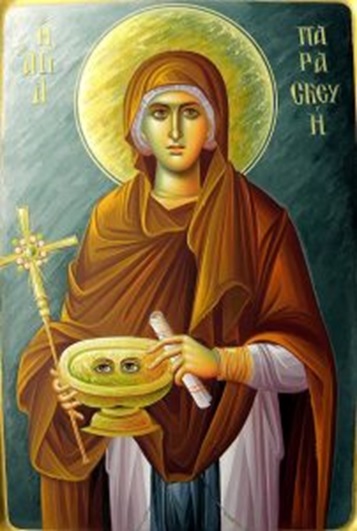Saint Paraskevi (26 July)
26 July 2023Sanctity is testimony to Jesus Christ. In other words, through their life and death, the saints imitate, witness to and confirm the divine personage and redemptive work of Jesus Christ, which is his teaching, his miracles, his sufferings and his resurrection. As Saint Paul says this testimony: ‘occurs either through life or death’. That is to say martyrs (i.e. witnesses) are the same whether they die ‘by the sword’ or end their days ‘in peace’. Saint John the Damascan calls the witness of ascetics ‘more extended and taxing’. Together with the martyrdom of blood, there’s also that of the conscience.
And in the choir of the saints of the Church, there are many who were not only blessed ascetics but also victorious martyrs. This is why they’re known as ‘blessed martyrs’. One such is Saint Paraskevi whose memory the Church keeps and honors today. She lived in the environs of Rome during the reign of Antoninus, i.e. 138-161. Her father was called Agathon, her mother was Politeia and both were devout Christians. They were childless, however, so they prayed to God and entreated him to send them a child. God heeded the prayer of the devout couple and a girl was born to them. She was born on a Friday and so was called Paraskevi [the Greek word for Friday].

Paraskevi was born through the prayers of her parents and was brought up with prayers and devotion to God. By the time she came of age, Paraskevi was a very beautiful young woman, but she believed that the true beauty of a Christian woman is ‘the person hidden in the heart’, as she’d read in Saint Peter’s first epistle. When her parents died, she distributed her property and devoted herself to missionary work, for which she was arrested.
The emperor himself wanted to interrogate Saint Paraskevi. Seeing her beauty and good sense, he told her that, if she sacrificed to the gods, she would have much to gain; otherwise, she’d be tortured. She replied that she’d never renounce Christ; that their gods were idols; and that there is only one true God, who made heaven and earth. When people in power discovered their inability to persuade those who confessed the faith, they used force and began to torture them. They set a red hot iron band on the saint’s head, but she was unscathed. They cast her into boiling pitch, but again she came to no harm. A few drops of this tar flew into the eyes of the emperor and blinded him, but Saint Paraskevi cured him.
History tells us that Antoninus, or Marcus Aurelius, was generally a good person and, following this miracle, he set the saint free. Paraskevi therefore left that city and went to another one to continue her missionary work. But she was arrested there, as well, and taken before the governor. When he suggested she renounce her faith, she made the sign of the cross and boldly confessed Christ. Outside this town, a fierce wild animal lurked in a cave. Saint Paraskevi was thrown into this cave, but when the beast launched itself to attack her, she blew on it and it died on the spot. When the governor and the executioners saw the miracle, they believed and again set Saint Paraskevi free.
Jesus Christ said that the saints he sent to preach the Gospel would be hounded ‘from city to city’. This was also the case with Saint Paraskevi. She went to another city, where again they arrested and interrogated her; and again she boldly confessed Christ. When they saw that they couldn’t convince her to renounce Christ, they tortured her and, in the end, cut off her head. In Orthodox iconography, she’s depicted as bearing her severed head on a platter, in the same manner as Saint John the Baptist. In one of his homilies, Saint John Chrysostom says that this is how the martyrs pray to Christ for us: holding their severed heads in the palms of their hands. Amen.






